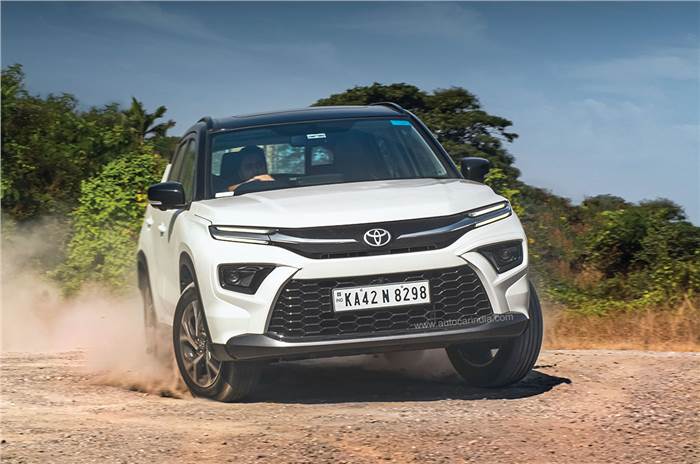Toyota Urban Cruiser Hyryder review, road test
We put Toyota’s newest SUV through our full-blown tests to see if it has what it takes to make it in the midsize market.
Published on Feb 12, 2023 09:00:00 AM
1,33,710 Views
Follow us on

Interior is stylish, but rivals offer better fit-finish.

Mild-hybrid’s 355-litre boot is large, well-shaped; Hybrid’s is 100-litre smaller.
Toyota’s hybrid powertrain consists of a 1,490cc, three-cylinder petrol engine, an electric motor and an e-CVT gearbox. It runs an Atkinson cycle where the intake valves remain partially open during the compression stroke, in the interest of efficiency. As a result, despite being larger in volume than the other petrol engine (1,462cc), its power output is lesser than the latter; it produces 92hp/122Nm by itself (while the other petrol engine makes 11hp/15Nm more).
The electric motor draws energy from a 0.76kWh lithium-ion battery pack. What’s interesting is that not only can the electric motor solely power the vehicle for a short while, the vehicle by default, starts in EV mode. Besides powering the vehicle, the motor also acts like a generator and recharges the battery when the vehicle is free-rolling or when the petrol motor is running. Transmission duties are carried by an e-CVT, which isn’t a conventional belt and pulley set-up, but a sun and planetary gearbox that channels power to the front wheels.

So long as you are gentle on the accelerator, it’ll roll purely on battery power. In fact, in peak hour traffic, you’ll find the vehicle in EV mode for the most part. When the battery’s charge drops below a certain threshold or when you demand quicker performance, the petrol engine fires up to provide that added surge. The transition from electric to petrol is supremely smooth, however, the three-cylinder engine breaks the calm and silence inside the cabin, and it even emits mild vibrations, so refinement isn’t its strong suit.
| Toyota Urban Cruiser Hyryder Price, Mileage, Specifications, Features and Variants | |
|---|---|
| Brand | Toyota |
| Model Name | Urban Cruiser Hyryder |
| Toyota Urban Cruiser Hyryder Price | ₹ 13.02 - 23.24 lakh |
| Toyota Urban Cruiser Hyryder Range/Mileage | Petrol Hybrid : 27.97kpl | Petrol : 19.39 - 21.12kpl |
| Toyota Urban Cruiser Hyryder Specifications | SUV | 5 doors | 5 seats View All Specs |
| Toyota Urban Cruiser Hyryder Features | LED headlight | 9-inch Touchscreen display | 6 airbags View All Features |
| Toyota Urban Cruiser Hyryder Variants | 1.5 Petrol Mild Hybrid E MT | 1.5 Petrol Mild Hybrid S MT | 1.5 Petrol Mild Hybrid S AT View All Variants |
What owners will appreciate is its zippy nature, and the petrol engine with instant electric torque assists makes light work of quick overtakes and nipping in and out of traffic gaps. With your foot pinned to the floor, the engine does get audible, and while there isn’t a strong turbo-petrol-like surge, the hybrid powertrain is brisk in its own way. So while drivability is surprisingly good, outright performance isn’t very exciting with a 0-100kph acceleration time of under 12 seconds; and its turbo-petrol rivals offer stronger performance and are appreciably much faster.
 Hybrid is more responsive than the mild-hybrid and performs effortlessly.
Hybrid is more responsive than the mild-hybrid and performs effortlessly.
The other engine in the line-up is Maruti’s K15C 1.5-litre petrol engine, shared with the Grand Vitara and Brezza. Not to be confused with the hybrid, dubbed as ‘Neo drive’, this is a mild-hybrid unit, which features automatic engine stop-start, torque assist as well as brake energy recuperation, to aid fuel efficiency. This one is offered with three drivetrain options – a 5-speed manual with either a front-wheel or an all-wheel drive layout and a 6-speed torque converter (automatic) with front-wheel drive only.
Making a strong first impression is this four-cylinder engine’s refinement, which is noticeably better than the hybrid version. It is dead silent at idle and only gets vocal when the tachometer needle swings closer to the redline. Throttle responses are pretty sharp too, and the flow of performance is smooth and linear with no sudden spikes or flat spots across the rev band. It certainly feels adequate to keep up with the flow of traffic, and purely as a point A to B commuter, it does the job.
 Electronically controlled all-wheel drive system gets four modes.
Electronically controlled all-wheel drive system gets four modes.
Get to an open road, however, and you’ll be yearning for more power. Overtaking long trailers on two-lane roads will require careful planning and you will need to work the gears along the way too. Thankfully, the 5-speed manual transmission is slick and very easy to operate, and so is the effort-free clutch. Talking numbers, this iteration hits 100kph from a standstill in 14.01 seconds, which is slow by segment standards, and even in-gear acceleration times are among the slowest in class.

We sampled the AWD version that features Suzuki’s All Grip Select, which is essentially an electronic coupling-based all-wheel drive system. The ‘Select’ in its name stands for the switchable drive modes – Auto, Snow, Sport and Lock. In ‘Auto’, the system is predominantly front-wheel driven, and when the plethora of sensors detect wheel slippage, the system sends power to the rear wheels, thus improving traction. In ‘Lock’ mode, it sends 50 percent of the power to the rear wheels and with the help of ESP and electronic wizardry, it is capable of tackling some sticky situations. Those who regularly drive in snowy or slushy conditions will find value in the AWD system.
Copyright (c) Autocar India. All rights reserved.



.jpg&w=234&h=156&q=90&c=1)

Comments
Member Login
Personal Details
No comments yet. Be the first to comment.